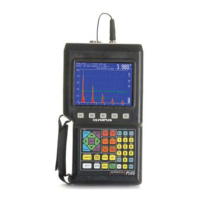102
EPOCH 4PLUS
includes the TVG gain adjustment slope line to visually define the gain changes across the
visible screen range as defined by the TVG setup and/or TVG Table setup.
9.4.9 Advanced DAC/TVG and the EPOCH 4PLUS Datalogger
Advanced DAC/TVG setups, curves, and inspection data can be easily stored in the
EPOCH 4PLUS datalogger. If data is stored using the [SAVE THICK] key, the instrument
will store only the file name, ID, and measurement value (soundpath distance/time, NOT
the DAC or TVG amplitude/dB comparison value). If data is stored using the [SAVE
WAVE] key, the instrument will store the file name, ID, measurement value (soundpath
distance/time), DAC/TVG evaluation (% amplitude or dB), Curve Adjustment Gain
level, active function name (ASME, ASME-3, Custom), all instrument setup parameters
(including scanning gain and/or reference correction settings), and the live A-Scan with
the DAC or TVG curve overlaid. In the case of a TVG Table setup, pressing [SAVE
WAVE] will also save the full TVG Table for reference.
When a saved setup is recalled from the datalogger, the instrument will display the
recalled setup in FREEZE Mode on the screen. All parameters, including DAC/TVG
setups and the TVG Table, are applied to the instrument. However, the operator
CANNOT edit DAC/TVG points or customize the TVG Table.
9.5 Low Pulse Repetition Frequency (LPRF)
Pulse Repetition Frequency (PRF) is a measure of how often the transducer is being
pulsed by the electronic circuitry in the EPOCH 4PLUS. The standard PRF setting of the
EPOCH 4PLUS is “Auto,” where the PRF changes automatically from 60 Hz to 360 Hz
depending on the range setting.
For some applications, it may be necessary to lower the PRF rate below 60 Hz to avoid a
phenomenon known as “wrap-around noise.” This can sometimes occur when testing
long soundpaths and can result in random noise and echoes on the A-Scan display. The
Low PRF option locks the PRF on the EPOCH 4PLUS at 30 Hz.
9.5.1 Activating Low PRF Mode
To activate the Low PRF mode, follow these steps:
1. Press [OPTION].
2. Use the slewing keys to highlight the PRF selection and press [ENTER].
3. Use the slewing keys to highlight LOW and press [ENTER].
4. Press [OPTION] to return to the A-Scan display. A “LPRF” symbol displays on the
right side of the screen to inform you that the Low PRF mode is enabled.
9.5.2 Exiting Low PRF Mode
To exit the Low PRF mode, follow these steps:
1. Press [OPTION].

